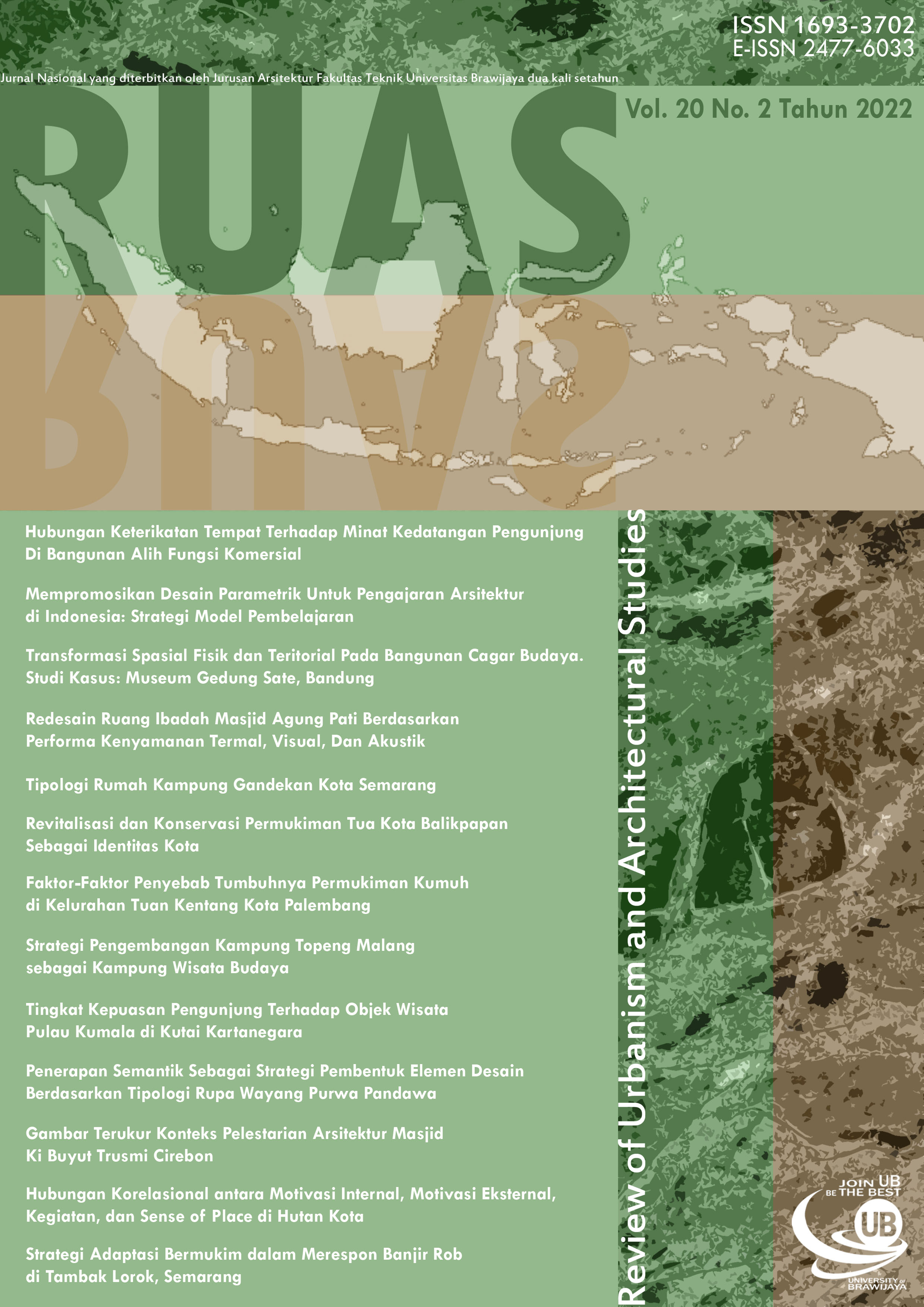Revitalisasi dan Konservasi Permukiman Tua Kota Balikpapan Sebagai Identitas Kota
DOI:
https://doi.org/10.21776/ub.ruas.2022.020.02.6Keywords:
identity, revitalization, conservationAbstract
The development of a city can be influenced by several things, including the geographical location and the condition of the natural resources of the region or area, one example is the city of Balikpapan whose development was initiated by the presence of petroleum natural resources, so that until now the city of Balikpapan is still known as "Oil City". Another advantage that makes the development of the city of Balikpapan is faster because it is supported by the geographical condition of the city of Balikpapan so that it becomes more strategic and is used as a stopover place both between cities and between provinces. As a stopover, the characteristics that can become the identity of a region are very important. To realize this, this research was carried out, using descriptive and qualitative methods in analysis and discussion. From the results of the analysis, it is known that it is necessary to maintain the physical form of an area, especially those that have historical values in the course of city development, one of which is by revitalizing and conserving areas in the city.
References
Adhi Nugraha, (2012), Transforming Tradition: A Method for Maintaining Tradition in a Craft and Design Contex, Aalto University publication series, doctoral dissertations, Helsinki.
Aguspriyanti, C. D., Nimita, F., & Deviana, D. (2020). Analisis Faktor-Faktor Penyebab Kekumuhan Di Permukiman Pesisir Kampung Tua Tanjung Riau. Journal of Architectural Design and Development, 1(2).
Alfani, T. (2008). Pengaruh Waktu Terhadap Identitas dan Image Kawasan. Retrieved Nopember 2017.
Asmania, H., Herbasuki Nurcahyanto, dan Mariyam Musawa. (2014). Strategi Penataan Kawasan Kota Lama. Journal of Public Policy and Management Review, 3(1), 1-10.
Dona P. Crouch dan June G.Johnson, 2001, Traditions in Architecture – Africa,America, Asia and Oceania, New York: Oxford Press
Heidari, A. A., & Mirzaii, S. (2013). Place Identity and its informant parameters in Architectural studies. Journal of Novel Applied Sciences, 260-268.
Kurniasih, S. (2007, November). Usaha Perbaikan Permukiman Kumuh di Petukangan Utara - Jakarta Selatan. p. http://peneliti.budiluhur.ac.id.
Lalli, M. (1992). Urban-Related Identity: Theory, Measurement, and Empirical Findings. Journal of Environmental Psychology, 12, 285-303.
Surtiani, E. (2006). Faktor Yang Mempengaruhi Terciptanya Kawasan Permukiman Kumuh Di Kawasan Pusat Kota. Tesis Magister Teknik Pembangunan Wilayah dan Kota Program Pasca Sarjana Universitas Diponogoro: Semarang
Suwarno, H. (1989). Artikel: Konsep Identitas. Majalah KOTA, edisi Januari/ Februari 1989. Retrieved Nopember 2017.
Pemerintahan Kota Balikpapan. (2013). Rencana Pembangunan Jangka Menengah Kota Balikpapan 2016. Balikpapan [ID]: Pemda Kota Balikpapan.
Peraturan Menteri Pekerjaan Umum, (2013). Pedoman Revitalisasi Kawasan. No.18/ PRT/ M/ 2010. Jakarta.
Pribadie, A. (n.d.). Teori Kota dan Permukiman. Retrieved September 3, 2017, from Academia: http://www.academia.edu
Ruli As’ari, & Siti Fadjarajani. (2018). Penataan Permukiman Kumuh Berbasis Lingkungan. Jurnal Geografi : Media Informasi Pengembangan Dan Profesi Kegeografian, 15(1). https://doi.org/10.15294/jg.v15i1.11888
http://www.pengertianku.net/2015/08/pengertian-konservasi-dan-tujuannya-serta-manfaatnya. Diakses Desember 2017
Downloads
Published
How to Cite
Issue
Section
License
Authors who publish with this journal agree to the following terms:
- Authors retain copyright and grant the journal right of first publication with the work simultaneously licensed under a Creative Commons Attribution License that allows others to share the work with an acknowledgement of the work's authorship and initial publication in this journal.
- Authors are able to enter into separate, additional contractual arrangements for the non-exclusive distribution of the journal's published version of the work (e.g., post it to an institutional repository or publish it in a book), with an acknowledgement of its initial publication in this journal.
- Authors are permitted and encouraged to post their work online (e.g., in institutional repositories or on their website) prior to and during the submission process, as it can lead to productive exchanges, as well as earlier and greater citation of published work (See The Effect of Open Access).












